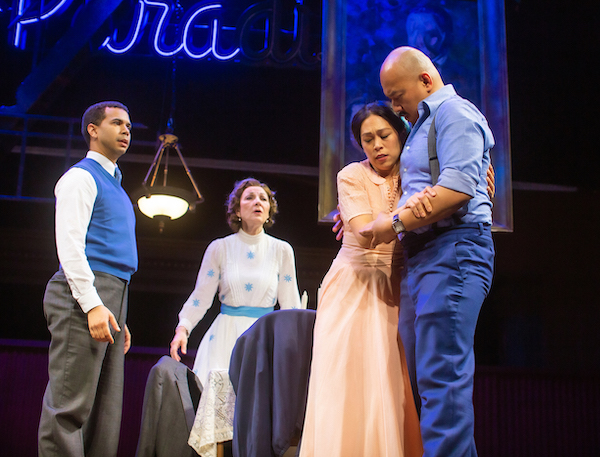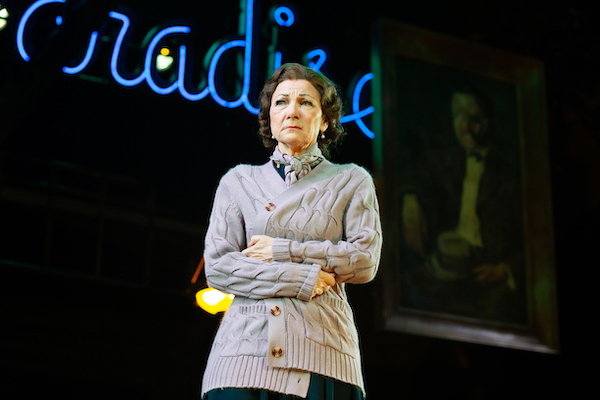
The Wingfields’ wings have been clipped.
That’s the burning kernel of pain at the center of “The Glass Menagerie,” Tennessee Williams’ oft-revived 1944 family drama, now playing in a frustratingly unfocused production directed by Jeffrey Lo at the San Francisco Playhouse.
Williams coined the description “memory play,” to describe the piece’s narrative structure, in which one character recalls scenes from their life which they then enact along with the rest of the cast.
Narrator Tom Wingfield (Jomar Tagatac, solid but not particularly distinctive in his take on the role), speaking from an abstract and undefined future, reflects on a period of his young adulthood when he, his physically and psychologically disabled older sister Laura (Nicole Javier), and their anxious fantasist mother Amanda (played with brilliant ferocity by Susi Damilano) struggle to make ends meet in a dingy, cramped St. Louis apartment after being abandoned by the wanderlusting family patriarch, whose portrait still holds a place of prominence in their home and psyches.
Drifting memories
Tom, a fictionalized stand-in for playwright Williams, who drew heavily on his own early life in the script, works in a mind-numbing warehouse job to support the family while aspiring to become a writer and see the world.
His regular evening excursions to the cinema (or, subtextually, to clandestine assignations) provide a taste of escape while simultaneously heightening the bitterness of his current confinement.
Amanda, clinging to her past as a well-to-do debutante, projects her southern belle fantasies onto her daughter, desperate to marry the whole family up by finding a husband for Laura. (William Hodgson plays the Gentleman Caller in the second act).
And Laura, utterly lacking in self-esteem, is said to dwell largely in a gauzy dreamworld populated by her collection of collectible crystal animals.
Between Lo’s direction of Javier, whose Laura is recessive and colorless, and what comes across as his willful desire to deemphasize the play’s titular symbol, this play about unstable people becomes destabilized itself. There’s not enough of an anchor to hold Tom’s slipstream memories together coherently.
The scenes wave and wander with a vaporous shapelessness. This could fairly be described as dreamlike. But also as inducing drowsiness.
Unpressured presentation

Part of what makes dreams compelling is their compression: Powerful symbolism and unconscious yearnings are fused together into a mysteriously resonant story. Part of what makes a menagerie tragic is forced confinement.
But this production physically undermines the compression and confinement of Williams’ script: Rather than truncate the width and depth of the San Francisco Playhouse’s enormous stage to emphasize the claustrophobia of the Wingfield apartment, scenic designer Christopher Fitzer’s set makes the audience keenly aware of its vast dimensions.
While the apartment’s rooms are represented by a series of appropriately small, interconnected platforms, this construction is positioned in the center of the huge mechanical turntable built into the Playhouse stage, which rotates at junctures throughout the evening to reveal the apartment from a variety of angles.
This flies in the face of the script’s emphasis on the fact that we are seeing a story told from just one perspective: Tom’s. The turntable’s significant space requirements and elegant, fluid movement also undermine the frustrating sense of stasis and enclosure that Tom rails against.
(Let me pause to rail a moment myself: The San Francisco Playhouse organization overuses its turntable, coming up with reasons to employ it in virtually every production. Just because you own a feather duster doesn’t mean you have to tickle people with it at any available opportunity).
Interpretation or imposition
The set also allows the audience to see above and beyond the Wingfields’ walls, giving them not only a glimpse of the sign over St. Louis’ Paradise dance hall (a just-beyond-reach place of freedom and romance) but also a peek at the gilded proscenium that bordered the stage of Theatre on the Square, this auditorium’s former resident company, which had a far shallower stage and a far greater seating capacity.
That golden frame, along with visible “backstage” alleys to the left and right of the turntable where the actors, remaining in character, linger quietly during scenes when they are not in the apartment, suggest that director Lo is aiming to underscore the blur between memory and fictional playmaking that Williams toys with in Tom’s introductory speech (“I give you truth in the pleasant disguise of illusion…it is sentimental, it is not realistic.”).
Tagatac’s Tom occasionally scribbles on the pages of a blank book, then rips them out and hand them to other actors (Are these intended to be notes, like those provided by a director or writer to a play’s cast members?).
Williams’ 1940s narrative innovations don’t go nearly as far as the meta-theatrical gimmicks in so many contemporary theater works, but that’s the vein of association Lo seems to be mining here.
It distracts. It dilutes. And it ultimately clips the poetic wings of the script it’s meant to serve.
